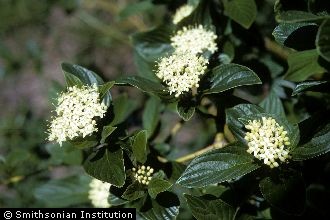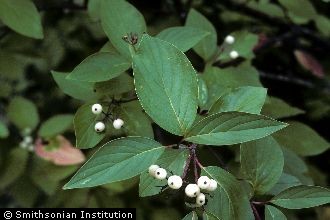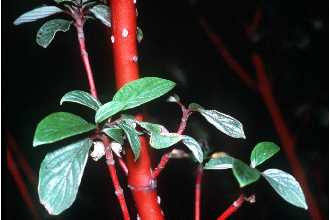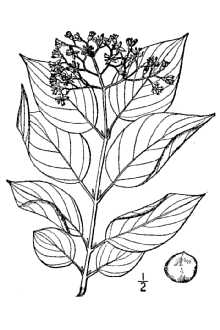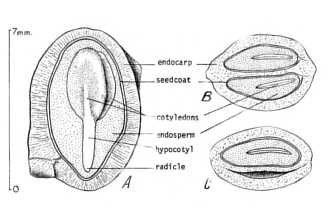Swida stolonifera (Michx.) Rydb.
Scientific Name: Swida stolonifera (Michx.) Rydb.
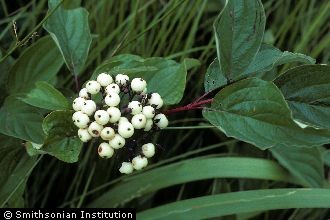
| General Information | |
|---|---|
| Usda Symbol | SWST2 |
| Group | Dicot |
| Life Cycle | Perennial |
| Growth Habits | ShrubTree, |
| Native Locations | SWST2 |
Plant Guide
Alternative Names
Red willow, redstem dogwood; Cornus stolonifera var. nevadensis Jepson and Cornus stolonifera Michaux (Hickman 1993). A related subspecies, Cornus sericia spp. occidentalis (Torr. & Gray) Fosberg is known as western dogwood.
Uses
Ethnobotanic: Native Americans smoke the inner bark of redosier dogwood in tobacco mixtures used in the sacred pipe ceremony. Dream catchers, originating with the Potawotami, are made with the stems of the sacred redosier dogwood. Some tribes ate the white, sour berries, while others used the branches for arrow-making, stakes, or other tools. In California, peeled twigs were used as toothbrushes for their whitening effect on teeth (Strike 1994). Bows and arrows were made from Cornus shoots. The inner bark is used for tanning or drying animal hides. The Apache, Cheyenne, Dakota, Montana Indians, Ojibwa, Potawatomi, Omaha, Ponca, and Thompson Indians all use the inner bark in a tobacco mixture for smoking the sacred pipe (Moerman 1986). The leaves and/or inner bark of redosier dogwood are also used as a smoking mixture by the Okanagan-Colville, the Flathead, the Kootenay, and the Blackfeet peoples in the western United States and Canada (Hellson 1974, Hart 1976, Turner 1978, Turner et al. 1980, Johnston 1987). The Navaho-Kayentaf and Navaho-Ramah used the plant ceremonially as a Mountain-top-way emetic (Moerman 1986). An infusion of redosier dogwood bark was used as an anti-diarrheal by the Chippewa and the Potawatomi, an antidote for weak kidneys by the Shuswap, and a pediatric aid for children who wet the bed by the Shuswap. The Chippewa used an infusion of the bark for eruptions caused by poison ivy. The Chippewa and the Micmac used a decoction of redosier dogwood root for sore eyes and catarrh. The Okanagan and the Thompson Indians took a decoction of the leaves. Other remedies treated by redosier dogwood included headaches, sore throats, a wash for ulcers, a substitute for “larb”, and a decoction of bark was taken as an antidote for weakness. The Maidu of Northern California used redosier dogwood as a tonic, a laxative, emetic, and cathartic (Strike 1994). Maidu women took a dogwood decoction after childbirth. The fruits were eaten by the Indians of the Missouri region (Densmore 1974). The berries are known to be tart and bitter, but were nonetheless eaten by all of the southern Interior peoples of British Columbia, including the Nlaka’pamux, Lillooet, Okanagan-Colville, Shuswap, Kootenay, Blackfeet, and the Flathead of Alberta and Montana (Kuhnlein and Turner 1991). The fruits were gathered from August to October and eaten fresh, a few at a time, or, more commonly, were pounded and mixed with other fruits, such as chokecherries (Prunus virginiana) or Saskatoons (Amelanchier almifolia). Some people mashed the berries and dried them in cakes; others dried and stored them. Eating a few raw fruits was considered to be a good tonic among the Nlaka’pamux and the Okanagan-Colville, who ate them, raw as a kind of “relish” (Turner 1978; Turner et al. 1990). Redosier dogwood is used for basket weaving. Sometimes called red willow, both Salix species and Cornus sericea are used interchangeably. Differences in stem color create a multi-hued design element. Indian people from the mid-Columbia River used redosier dogwood to make “ribbons” for basket decorations (Schlick 1994). If gathered in the early spring, the bark will retain its deep red color when dried and could be mistaken for cherry. The Hidatsa, Arikara, and Mandan made twill plaited burden baskets with two-toned dark and light designs; these baskets were made of willow (Salix nigra), redosier dogwood, and boxelder (Acer negundo) splints (Turnbaugh et al. 1986, Hart 1976). Willow and redosier dogwood were used by the Cheyenne, Arapaho, Kiowa, Pawnee, and Teton Sioux to make a coarsely coiled gambling basket for dice. The Ojibwa and the Chippewa used redosier dogwood bark as a dye. The inner bark was mixed with other plants or minerals and used to make a red dye, a light red dye, a black dye, and an ecru or “khaki” colored dye (Densmore 1974). Wildlife: The fleshy fruits of dogwoods are very valuable to wildlife, particularly in the Northeast (Martin et al. 1951). The fruit ripens in late summer, and besides being available through the fall, some of the berries may persist on the plants into the winter months. Wildlife browse the twigs, foliage, and fruits. Birds known to eat the fruit include: wood ducks, eastern bluebirds, cardinals, catbirds, long-tailed chats, crows, purple finches, yellow-shafted flickers, crested flycatchers, grosbeaks, kingbirds, American magpies, mockingbirds, crested mynah birds, orioles, robins, yellow-bellied sapsuckers, European starlings, tree swallows, scarlet tanagers, brown thrashers, thrushes, vireos, pine warblers, cedar waxwings, and woodpeckers. Game birds who eat both the fruits and buds include grouse, ring-necked pheasants, band-tailed pigeons, greater prairie chickens, bobwhite quail, and wild turkeys. The shrubs provide excellent nesting habitat for songbirds. Mammals that eat the fruit and foliage include black bear, beaver, mountain beaver, cottontail rabbits, raccoons, eastern skunks, squirrels, chipmunks, mice, and rats. Deer, elk, Mountain goat, and moose browse the twigs and foliage. Landscaping & ornamental: Redosier dogwood is often planted as an ornamental, both to beautify the landscape and to attract birds. Dogwood is often used for landscaping and as a secondary plant in windbreaks.
Status
Please consult the PLANTS Web site and your State Department of Natural Resources for this plant’s current status, such as, state noxious status and wetland indicator values.
Description
General: Dogwood Family (Cornaceae). Redosier dogwood is a woody deciduous shrub generally 1.4-6 m (4.6-20 ft) tall. The bark and twigs are reddish to purple and fairly smooth from autumn to late spring; after the leaves have fallen, the deep burgundy branches add color to the winter landscape. The bark, twigs, and leaves are bright green in spring through summer. The simple, opposite leaves are 5-10 cm (2-4 in) long, dark green above and hairy and lighter-colored below, with smooth margins, rounded bases, pointed tips, and falsely parallel veins. Flowering occurs from June to August. The inflorescence is a cyme, with 2-3 mm (0.08-0.12 in) white to cream-colored flowers. The white berries are smooth on the faces, furrowed on the sides.
Distribution
For current distribution, please consult the Plant Profile page for this species on the PLANTS Web site. Redosier dogwood has a wide distribution from California north to Alaska and throughout the country to the eastern United States south to Mexico. It generally grows at elevations below 2500 m.
Establishment
Adaptation: Redosier dogwood grows in soils that are saturated for at least a portion of the growing season. Redosier dogwood is common on the edges of lakes, ponds, within wetlands, and along streams. Not as tolerant of long-term root saturation as are some other shrubs, dogwood seems to prefer wetland margins where soils are nitrogen-rich, saturated, and shallowly inundated in the spring, and may be completely dry by late summer. It is tolerant of fluctuating water tables. The “osier” in redosier dogwood is derived from French, meaning “willow-like”; it is often called red willow because of its red stems. Propagation from cuttings: Redosier dogwood can be started easily by division, French layering, and hardwood cuttings. To propagate suckers by division: • Lift a root with suckers on it without disturbing the parent plant. Check that there are fibrous roots at the base of the suckers. • Remove the suckering roots by cutting it off close to the parent plant. Firm the soil around the parent plant. • Cut the main root back to the fibrous roots, then divide the suckers so that each has its own roots. Cut back the top-growth by about half. • Treat each sucker or hardwood cutting at the base with IBA at 20,000 ppm liquid formulation to promote rooting. Alternatively, treatment with 2 percent IBA talc; this will promote rooting on both suckers and stem cuttings. • Replant the suckers in open ground in prepared holes with good potting soil. Firm the soil around the suckers and water. • Before growth starts in the spring, lift the plant. Break the clump into sections, retaining those with vigorous shoots and well-developed roots. • Prune any damaged roots, and cut back the top-growth by one-third to a half to reduce water loss. Replant the divisions in the open and water in dry weather. • Ultimately, simply lift a suckering root, sever it from the parent plant, and then replant it in the open. To ensure survival of cuttings or suckers through the following winter in cold climates, the potted cuttings should be kept in heated cold frames or poly-houses to hold the temperature between 0-7°C (32-45°F). Rooted cuttings that had shoot growth in the fall, but were not given nitrogen, had the best over-winter survival in a cold frame with microfoam. French layering: Layering is a method where a stem is encouraged to develop roots before being removed from the parent plant. • In spring, plant a rooted layer or young plant, label it, and grow it for a season. Then, in the dormant season, cut back the stem to within 3 inches (8 cm) of the ground. • In the following spring, apply a balanced fertilizer at the rate of 2-4-oz/sq yd (60-110 g/sq m). Space the stems evenly again; dropping each into a 2-inch (5-cm) deep trench. Peg down each stem and cover with soil, leaving the shoot tips exposed. Hill up all but 2-3 inches (5-8 cm) of the new shoots as they develop, until the mound is 6 inches (15 cm) high. Water as needed. • After leaf fall, carefully fork away the soil from around the new shoots until the stems that were laid horizontally are exposed. Cut these flush with the basal area of the stems. Then cut the stems to separate the rooted sections. Pot these or plant them out in the open garden, and label them. The same redosier dogwood basal area may be used to propagate further layers. Propagation by seed: Redosier dogwood is established easily from seed. The best germination is obtained if the seeds are gathered as soon as the fruit starts to color or ripen, from August to October. If the seeds are allowed to dry out, it is best to remove seeds from the fruit and soak in water. The best results are obtained from fall sowing of freshly harvested seeds. Fruits collected too late to sow in the fall should be stored, pre-chilled until the next season, and sown outdoors the following fall. To effectively condition the seed for germination, store for two months in moist sand at 5ºC for 90 days. After pre-chilling, expose the seeds to fluctuating temperatures from 12/72ºC for 10 days (Young and Young 1992). With some species, the warm stratification period may be replaced by mechanical scarification or soaking in sulfuric acid. Seeds sown in nursery beds should be covered with 0.25-0.5 in (0.6-1.25 cm) of soil. Fall-sown beds should be mulched during the winter.
Management
Redosier dogwood is often coppiced in late fall after the leaves turn brown and fall off the stem. Cut all stems to approximately 2-3 in (5-8 cm) from the base before growth begins in spring. Apply fertilizer around the shrub to promote new growth, then apply mulch around the base. Coppicing stimulates the growth of new, vigorous stems whose deep burgundy color is especially vivid. Traditional resource management: Redosier dogwood was traditionally tended by pruning or burning to produce long straight stems. • Often basket weavers will prune many redosier dogwood stems, sometimes replanting the stems, so there will be nice straight basketry material the following year. • Before gathering, offerings of thanks and prayers for permission to gather are given. Often tobacco or sage or other offerings are given before beginning to gather. • Basket weavers process materials with their hands and mouths. Herbicides sprayed along streams have a much higher health risk for humans when they are processed and used for traditional materials. Overgrazing, especially by livestock and big game, frequently changes plant species composition and growth form, density of stands, vigor, seed production of plants, and insect production. Livestock grazing can cause the replacement of bird and mammal species requiring the vertical vegetation structure of riparian habitat to species, which are ubiquitous in their habitat preferences. Previous heavy cattle grazing changed the bird and small mammal community composition in riparian areas through reduction of shrub and herbaceous cover. Cultivars, Improved and Selected Materials (and area of origin) Cultivars: ‘Alman’s Compacta’, ‘Allamans’, ‘Bailey’, ‘Cardinal’, ‘Coloradensis’, ‘Flaviromea’, ‘Isanti’, ‘Kelseyi’, ‘Lutea’, ‘Ruby’, ‘Silver’ and ‘Gold’, and ‘White Gold’ have been planted in the growing range of redosier dogwood. Consult your local nurseries to choose the right cultivar for your specific landscape.
References
Beichel, C,, E, McDonald, & T, Cole (eds, Use soil moisture sensors to measure the soil moisture of Swida stolonifera (Michx.) Rydb..,) 1993, Encyclopedia of gardening, Dorling Kindersley, London, New York, Stuttgart, 648 pp, Densmore, F, 1974, How Indians use wild plants for food, medicine, and crafts, Dover Publications, Inc, New York, New York, 397 pp, Farley, G,H,, L,M, Ellis, J,N, Stuart, & N,J, Scott, Jr, 1994, Avian species richness in different-aged stands of riparian forest along the middle Rio Grande, New Mexico, Conservation Biology 8: 1098-1108, Fleishner, T,L, 1994, Ecological costs of livestock grazing in western North America,
Conservation
Biology 8: 629-644. Gilmore, M. 1977. Uses of the plants by the Indians of the Missouri River Region. University of Nebraska Press, Lincoln, Nebraska. Grinnel, G.B. 1962. The Cheyenne Indians. 2 vols. Cooper Square Publishers. New York, New York. Hart, J.A. 1976. Montana: native plants and early peoples. Montana Historical Society, Helena, Montana. Hartmann, H. T., D. E. Kester, & F. T. Davies, Jr. 1990. Plant propagation principles and practices. Prentice Hall, Englewood Cliffs, New Jersey. 647 pp. Hellson, J.C. 1974. Ethnobotany of the Blackfeet Indians. National Museum of Man, Mercury Series, Canadian Ethnology Service Paper No. 19. Hutchens, A.R. 1991. Indian herbalogy of North America. Shambhala, Boston and London. pp. 113-117. Isaacson, R. T. 1993. Anderson horticultural library's source list of plants and seeds. Anderson Horticultural Library. University of Minnesota Libraries. Minnesota Landscape Arboretum. 261 pp. Johnston, A. 1970. Blackfeet Indian utilization of the flora of the northwestern Great Plains. Economic Botany 24:301-24. Kinscher, K. 1992. Medicinal wild plants of the prairie. An ethnobotanical guide. University Press of Kansas. pp. 84-94. Kunlein, H.V. & N. J. Turner 1991. Traditional plant foods of Canadian indigenous peoples. Nutrition, botany, and use. Food and Nutrition in History and Anthropology Volume 8. Gordon and Breach Science Publishers. 632 pp. Martin, A.C., H. S. Zim, & A.L. Nelson 1951. American wildlife and plants. A guide to wildlife food habits. Dover Publications, Inc. New York, New York. 500 pp. McClintock, W. 1909. Materia medica of the Blackfeet. Zeitschrift fur Ethnologie: 273-279. McGregor, R.L. T.M. Barkley, R.E. Brooks, E.K. Schofield (eds.) 1991. Flora of the Great Plains. University Press of Kansas. 1402 pp. McGregor, R.L. 1968. The taxonomy of the genus Echinacea (Compositae). University of Kansas Science Bulletin 48(4): 113-142. Moerman, D.E. 1986. Medicinal plants of native America. Research reports in ethnobotany, Contribution 2. University of Michigan Museum of Anthropology. Technical Reports, Number 19. Ann Arbor, Michigan. pp. 156-158. Schlick, M.D. 1994. Columbia River Basketry. Gift of the ancestors, gift of the earth. A Samuel and Althea Strowm Book. University of Washington Press, Seattle and London. 232 pp. Smith, H.H. 1928. Ethnobotany of the Meskwaki Indians. Bulletin of the Public Museum of the City of Milwaukee 4(2): 175-326. Stephens, H.A. 1973. Woody plants of the North Central Plains. The University Press of Kansas. 530 pp. Stevens, L.E., B.T. Brown, J.M. Simpson, & R.R. Johnson 1977. The importance of riparian habitat to migrating birds. pp. 156-164. In: Johnson, R.R. & D.A. Jones (tech. coords.). Importance, preservation and management of riparian habitat: a symposium. USDA Forest Service Gen. Tech. Report RM-43. Rocky Mountain Forest and Range Experiment Station, Fort Collins, Colorado. 217 pp. Strike, S.S. 1994. Ethnobotany of the California Indians. Koeltz Scientific Books. USA/Germany. 210 pp. Turner, N.J. 1978. Food plant of British Columbia Indians. Part II. Interior Peoples. B.C. Provincial Museum Handbook No. 36, Victoria, B.C., Canada. Turner, N.J., L.C. Thompson, M.T. Thompson & A.Z. York 1990. Thompson ethnobotany: Knowledge and usage of plants by the Thompson Indians of British Columbia. Royal British Columbia Museum Memoirs No. 3, Victoria, B.C., Canada. Turner, N.J., R. Bouchard, & D.I.D. Kennedy 1980. Ethnobotany of the Okanagan-Colville Indians of British Columbia and Washington. B.C. Provincial Museum Occasional Paper No. 21. 179 pp. Turnbaugh, S.P., & W.A. Turnbaugh 1986. Indian baskets. Schiffer Publishing Ltd., West Chester, Pennsylvania. 260 pp. Young, A.J. & C.G. Young 1992. Seeds of woody plants in North America. Dioscorides Press, Portland, Oregon. USDA, NRCS 2000. The PLANTS database. Version: 000328. <http://plants.usda.gov>. National Plant Data Center, Baton Rouge, Louisiana.
Fact Sheet
Alternate Names
Cornus stolonifera Michx.
Uses
The primary use of this species is for streambank protection. It can be planted alone or with other species, such as willows. Other beneficial uses are for fish and wildlife habitat improvement, windbreaks, slope stabilization, borders, and as an ornamental.
Status
Please consult the PLANTS Web site and your State Department of Natural Resources for this plant’s current status (e.g. threatened or endangered species, state noxious status, and wetland indicator values).
Description
Redosier dogwood is a large shrub, often 6-9 feet in height. The growth habit is upright rounded, but where stems are in contact with the ground, roots are formed. This behavior creates thickets. This dogwood has bright red stems in the fall, winter and early spring, which turn greenish in the summer. It also has white pith, dark green ovate leaves, white flowers, and whitish colored fruit. There are 18,500 seeds per pound.
Adaptation and Distribution
Distribution
Distribution
Redosier dogwood is adapted from Ohio to Maine and south to northern Virginia and New Jersey. It performs best in soils that are moist, somewhat poorly drained, moderately acidic to neutral, and in areas that have medium to coarse soils. It is tolerant of some shade but not of droughty conditions. For a current distribution map, please consult the Plant Profile page for this species on the PLANTS Website.
Establishment
Streambanks that have steep slopes must first be graded. The slope should be 1:1 or flatter. Any trees considered unstable should be removed. One year old rooted cuttings should be used for planting. Plant in early spring, preferably before May. Do not plant after June 1. Plant the cuttings two feet apart for streambank erosion control, four to six feet apart for wildlife habitat. Establishment with other species, such as willow and other riparian species, is a good practice. On sites with banks that may become dry over the summer, utilize redosier dogwood next to the water, with willows above. Immediately after planting, grasses and legumes may be planted to provide initial stabilization. After 2 or 3 years the dogwoods will become effective. The cultivar 'Ruby' is vulnerable to livestock browsing. In order to ensure survival, fencing must be incorporated into the plan. Robert H. Mohlenbrock USDA NRCS 1989. Midwestern Wetland Flora @USDA NRCS PLANTS Redosier dogwood can also be mixed with willows in soil bioengineering methods. Stems can be used in live fascines, brush layering and brush mattressing. Rooted hardwood cuttings are taken in January, allowed to develop callus in refrigerated storage, and planted in mid-May in well drained soil 2 inches apart. The cuttings should be 1/4-1/2 inch in diameter and 9 to 12 inches long. They should be planted with about 2 inches exposed above ground level. Rooting hormone is recommended to enhance success in the nursery.
Management
Erosion is a continuous process and, because of this, careful management is required at these streambank plantings, The areas should be examined each spring after the major runoff period has ended, Areas where vegetation has been destroyed must be immediately replaced with new plants, If any mechanical measures are being used to prevent erosion, they must also be maintained to prevent any more damage, , Use soil moisture sensors to measure the soil moisture of Swida stolonifera (Michx.) Rydb..
Plant Traits
Growth Requirements
| Cold Stratification Required | Yes |
|---|---|
| Hedge Tolerance | Low |
| Hedge Tolerance | Low |
| Frost Free Days, Minimum | 90 |
| Frost Free Days, Minimum | 100 |
| Fire Tolerance | Medium |
| Fire Tolerance | Low |
| Fertility Requirement | Medium |
| Fertility Requirement | Low |
| Drought Tolerance | Medium |
| Drought Tolerance | Low |
| Cold Stratification Required | Yes |
| Temperature, Minimum (°F) | -38 |
| CaCO3 Tolerance | None |
| CaCO3 Tolerance | Medium |
| Anaerobic Tolerance | High |
| Anaerobic Tolerance | High |
| Adapted to Medium Textured Soils | Yes |
| Adapted to Medium Textured Soils | Yes |
| Adapted to Fine Textured Soils | Yes |
| Adapted to Fine Textured Soils | Yes |
| Adapted to Coarse Textured Soils | Yes |
| Adapted to Coarse Textured Soils | Yes |
| Moisture Use | Medium |
| Temperature, Minimum (°F) | -38 |
| Shade Tolerance | Intolerant |
| Shade Tolerance | Intermediate |
| Salinity Tolerance | None |
| Salinity Tolerance | Medium |
| Root Depth, Minimum (inches) | 20 |
| Root Depth, Minimum (inches) | 16 |
| Precipitation, Minimum | 24 |
| Precipitation, Minimum | 18 |
| Precipitation, Maximum | 60 |
| Precipitation, Maximum | 60 |
| Planting Density per Acre, Minim | 1212 |
| Planting Density per Acre, Minim | 1100 |
| Planting Density per Acre, Maxim | 4850 |
| Planting Density per Acre, Maxim | 2700 |
| pH, Minimum | 4.8 |
| pH, Minimum | 4.8 |
| pH, Maximum | 7.5 |
| pH, Maximum | 7.0 |
| Moisture Use | High |
Morphology/Physiology
| Active Growth Period | Spring and Summer |
|---|---|
| Toxicity | None |
| Toxicity | None |
| Shape and Orientation | Semi-Erect |
| Fire Resistant | No |
| Foliage Texture | Coarse |
| Foliage Texture | Coarse |
| Foliage Porosity Winter | Porous |
| Foliage Porosity Winter | Moderate |
| Foliage Porosity Summer | Moderate |
| Foliage Porosity Summer | Dense |
| Foliage Color | Green |
| Foliage Color | Green |
| Flower Conspicuous | Yes |
| Flower Conspicuous | Yes |
| Flower Color | White |
| Flower Color | White |
| Resprout Ability | Yes |
| Fire Resistant | No |
| Fall Conspicuous | Yes |
| Fall Conspicuous | Yes |
| Coppice Potential | No |
| Coppice Potential | No |
| C:N Ratio | High |
| C:N Ratio | High |
| Bloat | None |
| Bloat | None |
| Active Growth Period | Spring and Summer |
| Shape and Orientation | Semi-Erect |
| Fruit/Seed Color | White |
| Resprout Ability | Yes |
| Nitrogen Fixation | None |
| Nitrogen Fixation | Medium |
| Low Growing Grass | No |
| Low Growing Grass | No |
| Lifespan | Moderate |
| Lifespan | Long |
| Leaf Retention | No |
| Leaf Retention | No |
| Known Allelopath | No |
| Known Allelopath | No |
| Height, Mature (feet) | 12.0 |
| Height, Mature (feet) | 5.0 |
| Fruit/Seed Color | White |
| Fruit/Seed Conspicuous | Yes |
| Fruit/Seed Conspicuous | Yes |
| Growth Form | Multiple Stem |
| Growth Form | Multiple Stem |
| Growth Rate | Moderate |
| Growth Rate | Moderate |
| Height at 20 Years, Maximum (fee | 12 |
| Height at 20 Years, Maximum (fee | 5 |
Reproduction
| Propagated by Cuttings | Yes |
|---|---|
| Propagated by Seed | Yes |
| Propagated by Seed | Yes |
| Propagated by Sod | No |
| Propagated by Sod | No |
| Propagated by Sprigs | No |
| Propagated by Sprigs | No |
| Propagated by Tubers | No |
| Propagated by Tubers | No |
| Seed per Pound | 18400 |
| Seed per Pound | 18400 |
| Fruit/Seed Period End | Summer |
| Seed Spread Rate | Slow |
| Seed Spread Rate | Slow |
| Seedling Vigor | Medium |
| Seedling Vigor | Medium |
| Small Grain | No |
| Small Grain | No |
| Vegetative Spread Rate | Moderate |
| Vegetative Spread Rate | Slow |
| Propagated by Corm | No |
| Propagated by Cuttings | Yes |
| Bloom Period | Late Spring |
| Bloom Period | Spring |
| Commercial Availability | Routinely Available |
| Commercial Availability | Routinely Available |
| Fruit/Seed Abundance | Low |
| Fruit/Seed Abundance | Medium |
| Fruit/Seed Period Begin | Summer |
| Fruit/Seed Period Begin | Summer |
| Fruit/Seed Period End | Summer |
| Fruit/Seed Persistence | No |
| Propagated by Bare Root | Yes |
| Propagated by Bare Root | Yes |
| Propagated by Bulb | No |
| Propagated by Bulb | No |
| Propagated by Container | Yes |
| Propagated by Container | Yes |
| Propagated by Corm | No |
| Fruit/Seed Persistence | No |
Suitability/Use
| Palatable Browse Animal | Low |
|---|---|
| Palatable Graze Animal | Low |
| Palatable Human | No |
| Palatable Human | No |
| Post Product | No |
| Post Product | No |
| Protein Potential | Low |
| Protein Potential | Medium |
| Pulpwood Product | No |
| Pulpwood Product | No |
| Veneer Product | No |
| Veneer Product | No |
| Palatable Browse Animal | High |
| Nursery Stock Product | Yes |
| Nursery Stock Product | Yes |
| Naval Store Product | No |
| Naval Store Product | No |
| Lumber Product | No |
| Lumber Product | No |
| Fodder Product | No |
| Fodder Product | No |
| Christmas Tree Product | No |
| Christmas Tree Product | No |
| Berry/Nut/Seed Product | No |
| Berry/Nut/Seed Product | No |

